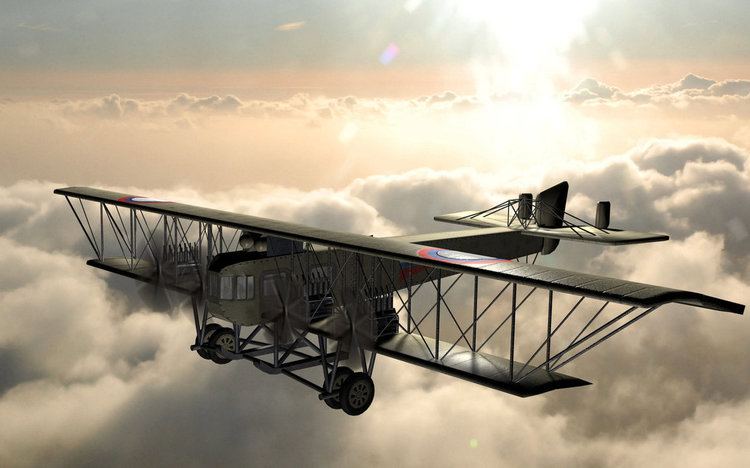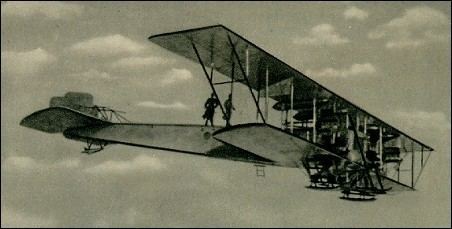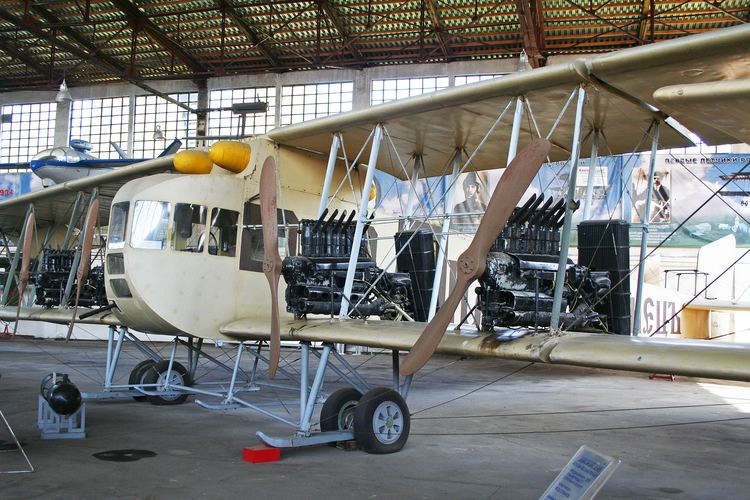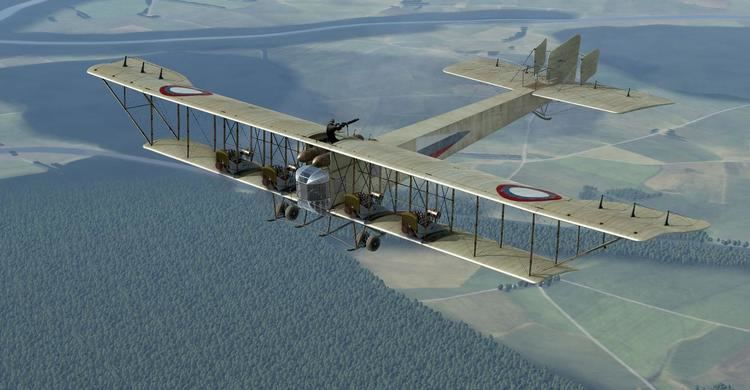Top speed 110 km/h Length 18 m Retired 1922 | Wingspan 21 m Introduced 1913 Manufacturer Russo-Balt | |
 | ||
Sal calvagna sikorsky ilya muromets first flight
The Sikorsky Ilya Muromets (Russian: Сикорский Илья Муромец) (Sikorsky S-22, S-23, S-24, S-25, S-26 and S-27) are a class of Russian pre-World War I large four-engine commercial airliners and heavy military bombers used during World War I by the Russian Empire. The aircraft series was named after Ilya Muromets, a hero from Slavic mythology. The series was based on the Russky Vityaz or Le Grand, the world's first four-engined aircraft, designed by Igor Sikorsky. The Ilya Muromets aircraft as it appeared in 1913 was a revolutionary design, intended for commercial service with its spacious fuselage incorporating a passenger saloon and washroom on board. During World War I, it became the first four-engine bomber to equip a dedicated strategic bombing unit. This heavy bomber was unrivaled in the early stages of the war, as the Central Powers had no aircraft capable enough to rival it until much later, with the 1916-17 origin Zeppelin-Staaken R.VI, the only example of any of the Imperial German Riesenflugzeug airframe designs to be produced in any quantity during World War I.
Contents
- Sal calvagna sikorsky ilya muromets first flight
- Sikorsky ilya muromets
- Design and development
- Operational history
- Russian Revolution and aftermath
- Variants
- Military
- Civilian
- Survivors
- Specifications Ilya Muromets Type S 23 V
- References

Sikorsky ilya muromets
Design and development

The Ilya Muromets (Sikorsky S-22) was designed and constructed by Igor Sikorsky at the Russo-Baltic Carriage Factory (RBVZ) in Riga in 1913. It was based on his earlier S-21 Russky Vityaz, which started out as the twin-engined Le Grand, then as the twin tandem-engined Bolshoi Baltisky before placing all four of the Baltisky's engines in a tractor configuration along the lower wing's leading edge to create the Russky Vityaz — which had played an important role in the development of Russian aviation and the multi-engine aircraft industries of the world.

Russia had a chance to become the birthplace of the first multi-passenger and multi-engine airliner. The Ilya Muromets was first conceived and built as a luxurious aircraft. For the first time in aviation history, it had an insulated passenger saloon, comfortable wicker chairs, a bedroom, a lounge and even the first airborne toilet. The aircraft also had heating and electrical lighting. The S-22 cockpit had sufficient space allowing several persons to observe the pilot. Openings on both sides of the fuselage permitted mechanics to climb out onto the lower wings to service the engines during flight. A hatch on the left side provided an entry to the main cabin, behind the cockpit. The main cabin featured two large windows on each side. Further back was a private cabin which included a berth, small table and a cabinet. Lighting was provided by a wind-driven generator and heating was supplied by two long engine exhaust pipes which passed through the corners of the cabin. Despite many advancements, the flight instruments on the Ilya Muromets were primitive. They included four tachometers, one per engine, a compass, a crude altimeter and airspeed indicator, two glass V-shaped tubes and a ball for bank indication, and a series of horizontal bars situated vertically on the nose of the fuselage for measuring climbs and descents. Later, in the bomber variants, a drift indicator and elementary bombsight was added to aid bombing.

On 10 December 1913, the Ilya Muromets No. 107 flew for the first time, and on 11 February 1914, the second prototype (factory airframe 128) took off for its first demonstration flight with 16 passengers aboard, marking a record for number of passengers carried. From 30 June to 12 July 1914, it set a world record by making a trip from Saint Petersburg to Kiev, a distance of some 1200 km, and back. The first leg took 14 hours and 38 minutes, with one landing for fuel at Orsha, and the return one, with a fuel stop at Novosokolniki, took even less time, about 13 hours. The acclaim received by Sikorsky included Tsar Nicholas II presenting him with the Order of St. Vladimir, Fourth Degree, arranging for an exemption from the wartime draft to allow him to continue his design work, and a promise of a grant worth 100,000 rubles from the State Duma. During an Imperial military review at Krasnoye Selo in July, Nicholas II decorated and christened the Ilya Muromets Type B Military Prototype, No. 128, the "Kievsky."

During testing, the Ilya Muromets were fitted with both skis and pontoons in anticipation of new variants being produced. If it had not been for World War I, the Ilya Muromets would probably have started passenger flights that same year.

With the beginning of World War I, Sikorsky was encouraged by the results of the proving flights to redesign the aircraft to become the "Military Ilia Mourometz, Type V, the world's first purpose-designed bomber. The new heavy bomber was slightly smaller and lighter than the Type A. Internal racks carried up to 800 kg of bombs, and positions for up to nine machine guns were added for self-defense in various locations, including the extreme tail. The Muromets (in its S-25 Geh-2 variant, March 1916) was the first aircraft in history to incorporate a tail gunner position. The engines were protected with 5 mm-thick armor. The military version was designed expressly for long-range flying in both bombing and reconnaissance roles.
Operational history
When war broke out, only two Ilya Muromets bombers were completed out of an initial production run of ten aircraft. In August 1914, the Ilya Muromets was introduced to the Imperial Russian Air Service and on 10 December 1914, the Russians formed their first ten-bomber squadron, slowly increasing the number to 20 by mid-1916. Operations with the heavy bombers began on 12 February 1915 with a raid on German frontline positions. During World War I, the Germans often were reluctant to attack Ilya Muromets in the air due to their defensive firepower including a unique tail gun position, and the difficulty in bringing down such a large aircraft. Once engaged, small fighters also found that they were buffeted by propeller wash. On 12 September 1916, the Russians lost their first Ilya Muromets in a fight with four German Albatros, three of which it managed to shoot down. This was also the only loss to enemy action during the war; three others were damaged in combat, but managed to return to base to be repaired.
The Russians built 83 Ilya Muromets bombers between 1913 and 1918. During this period, they were the first in aviation history to perform bombing from heavy bombers, with bomber group raids on enemy targets, night bombing, and photographic bomb damage assessment. They were also the first to develop defensive tactics for a single bomber engaged in an air combat with several enemy fighters. Due to systematic weapon upgrades, the effectiveness of bomb-dropping reached 90%.
The Ilya Muromets performed more than 400 sorties and dropped 65 tons of bombs during the war. By 1917, attrition from constant flying had reduced the bombing fleet substantially and only four bombers remained at the front line; the other Ilya Muromets were relegated to trainer duties. The heavy bombers of other participants appeared in 1916, all resembling the Russian pioneer to a certain degree. The Russian government and Sikorsky himself sold the design and production license to the British and French governments. The Germans tried to copy its design, using the fragments of the Ilya Muromets they had shot down over their territory in September 1916. By the end of 1916, the design was generally believed to be at the end of its development cycle, with ensuing modifications to individual aircraft, such as additional armor and weapons, making the aircraft too heavy and not suitable for operational use. Continual changes in the field as well as the factory led to many aircraft being redesignated as a new variant. Further designs based on the original Ilya Muromets bombers included a more dedicated attack version.
Russian Revolution and aftermath
Following the February Revolution of 1917, the Ilya Muromets bombers continued to fly with the Russian Imperial Army but others were seized by the provisional government with pilots also defecting to the Ukrainian squadron of Hetman and General Pavlo Skoropadsky, with at least one Ilya Muromets being flown by Polish forces. The remainder of the aircraft flew with the Red Army until mid-1919.
The Ilya Muromets continued in production after the war with a handful still being produced. From May–October 1921, the aircraft was utilized in its originally intended role of passenger transport on the Moscow-Kharkov line, six survivors continuing in service as a civilian passenger airliner and mail plane. After carrying 60 passengers and two tons of freight, the Ilya Muromets were considered too difficult to maintain as engines and airframes were worn out and on 10 October 1922, the airliners were retired. The last flight of an Ilya Muromets bomber took place in 1922 at the Air Shooting and Bomb-dropping School in Serpukhov.
Variants
Military
Civilian
Survivors
One Ilya Muromets S-22 replica exists in the Monino Air Force Museum near Moscow.
Specifications (Ilya Muromets Type S-23 V)
General characteristics
Performance
Armament
